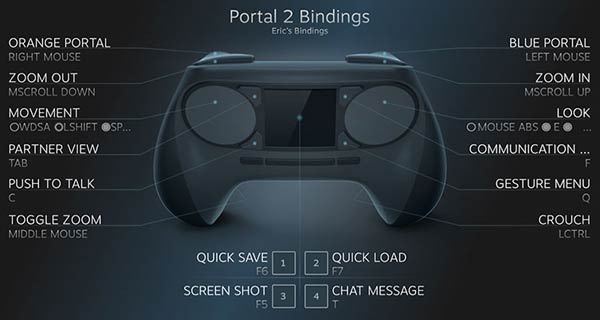Valve took the wraps off the Steam Controller a couple of hours ago, as its third and final reveal this week. This week Valve has been revealing parts of a jigsaw which, now they are put together, should give people a good idea of how the company aims to get people gaming via Steam in their living rooms.
On Monday we saw the company reveal SteamOS, an open operating system optimised for games and big TV entertainment. On Wednesday Valve revealed its plans for Steam Machines; “a powerful new category of living-room hardware,” which would start shortly with powerful beta hardware designed by Valve, used as a basis for a multitude of other companies to build market optimised Steam Machines next year.

Today we have been shown the “biggest missing link”, the Steam Controller. “We realized early on that our goals required a new kind of input technology — one that could bridge the gap from the desk to the living room without compromises. So we spent a year experimenting with new approaches to input and we now believe we’ve arrived at something worth sharing and testing with you,” says the Steam Controller intro page.

Let’s look at the hardware which makes up this new controller:
Dual trackpads: These thumb friendly “high-resolution” pads also click when pressed. We are told that both these trackpads have a similar resolution to your computer mouse. Largely due to these twin thumb track-pads, “whole genres of games that were previously only playable with a keyboard and mouse are now accessible from the sofa,” claims Valve.
Haptics: Because touch pads don’t have the physical presence of thumb sticks Valve had to implement “super-precise haptic feedback, employing dual linear resonant actuators”. As well as being great for gaming, “as a parlour trick they can even play audio waveforms and function as speakers,” we are informed.

Touch Screen: You can see this in the centre of the pad. It employs a “high-resolution screen”. The display can show contextual game controls, be used as a scrolling menu, a radial dial, provide secondary info like a map or use other custom input modes. In addition to its touch sensitive surface the whole screen is clickable like a big button.
Buttons etc: The Steam Controller also has 16 further physical buttons. The buttons are placed symmetrically so left and right handed people should be equally satisfied with the layout.
Software: Looking at legacy games support, Valve seems to think that it’s got that problem licked too, “We’ve fooled those older games into thinking they’re being played with a keyboard and mouse, but we’ve designed a gamepad that’s nothing like either one of those devices,” it proudly claims. In legacy mode the controller presents itself to the system as both a keyboard and mouse. Valve has a configuration tool which can utilise shared config files uploaded to the Steam Community – so you can use other people’s controller configs and share your own creations.
Finally the Steam Controller is said to be open and “hackable”. Interestingly Valve says that “we plan to make tools available that will enable users to participate in all aspects of the experience, from industrial design to electrical engineering”.

Now that all three parts of Valve’s strategy have been revealed do readers think that it has a good chance of taking a decent bite out of the home console market? Also would you be interested in using one of these controllers to play games on your PC?













